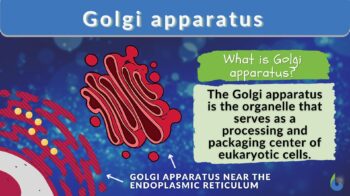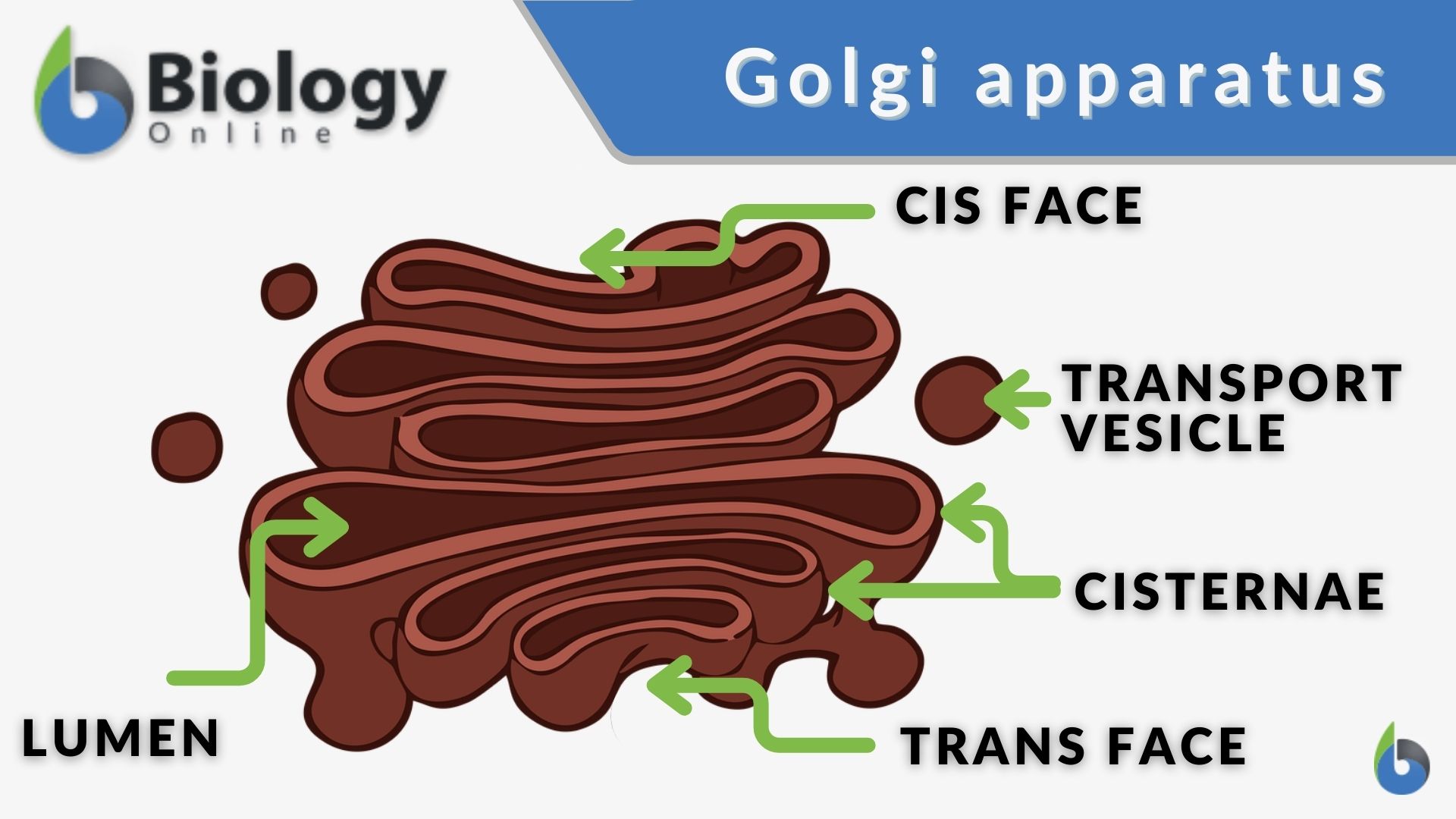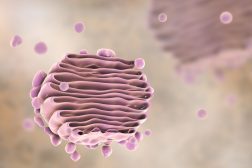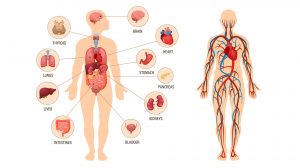
Golgi apparatus
n., plural:
[ˈɡol.ɡiː æp.əˈɹæt.əs]
Definition: A vital organelle that serves as the processing and packaging center of eukaryotic cells
Table of Contents
Golgi Apparatus Definition
The Golgi apparatus is a membrane-bound organelle in eukaryotic cells. It plays a crucial role in processing, modifying, and packaging various cellular products before they are transported to their designated locations. The protein processed by the rough endoplasmic reticulum for transport to the Golgi apparatus would be packed inside a transport vesicle. The vesicle containing the properly-folded protein is pinched off from the endoplasmic reticulum and then shuttled to the Golgi apparatus where the protein will undergo maturation (by post-translational modifications). The vesicle is transported from the endoplasmic reticulum along the cytoskeleton to the cis face of the Golgi. The contents of the vesicle are emptied into the lumen of the Golgi. Inside the lumen, the protein is modified, labeled with a signal sequence, and packed in a vesicle for transport to the next destination.
The Golgi apparatus is one of the most fascinating structures you’ll ever find within the cell. As this could be a topic for discussion in your class, especially in cell biology, might as well know the answers to common questions like ‘What exactly is the Golgi apparatus?’, ‘What does it look like’, and ‘What is its function?’
So let’s begin and learn the intricacies of this cellular structure.
Watch this vid about the Golgi apparatus:
Biology definition:
The Golgi apparatus is an organelle that is comprised of flattened sacs (Golgi cisternae) primarily involved in glycosylation, packaging of molecules for secretion, transporting lipids within the cell, and giving rise to lysosomes. In plants, this organelle is referred to as the dictyosome. In flagellate protozoa, it is called the parabasal body. The collective term for all the Golgi apparatus in the cell is the Golgi complex (or Golgi compartments).
Synonym: Golgi complex; Golgi body; paranasal body; Golgi; dictyosome
Golgi Apparatus Overview
A membrane-bound organelle
Is Golgi apparatus an organelle? Yes! As pointed out earlier, the Golgi apparatus is a membrane-bound organelle. Similar to the endoplasmic reticulum and lysosomes, the Golgi apparatus has a single lipid bilayer membrane as opposed to the double lipid bilayered membranes of other membrane-bound organelles, such as the nucleus, mitochondria, and plastids.
Part of the GERL system
The Golgi apparatus is one of the three components of the GERL system, together with the Endoplasmic Reticulum and the Lysosomes. The Golgi, in fact, is derived from the transport vesicles that bud off from the endoplasmic reticulum and have fused with the Golgi apparatus. The Golgi apparatus though can be identified from the endoplasmic reticulum by being composed of stacks of flattened sacs. Rather than a mesh network like the sacs of the endoplasmic reticulum are, the Golgi sacs are arranged in a stack. Imagine a pile of pancakes! But unlike pancakes that exist independently of each other, the Golgi stacks are interconnected, allowing the transport of cellular products.
History Of Discovery
Before we delve deeper, let’s name some prominent scientists that made huge contributions to the discovery of this organelle. As a matter of fact, the name of the structure is derived from its discoverer, Camillo Golgi. It was in the late 19th century when this Italian physician and scientist first observed this organelle under a microscope. His meticulous observations and discoveries laid the foundation for understanding the Golgi apparatus.
Characteristics of Golgi Apparatus
The Golgi apparatus (or simply Golgi) is an organelle in a eukaryotic cell dubbed as the “post office of the cell” or the “packaging center of the cell”. This is due to the many substances such as proteins that the Golgi processes by modifying and tagging/labeling for secretion.
Morphology
The Golgi apparatus consists of stacks of cisternae (sacs) with identifiable faces or regions. The cis is the entry face whereas the trans is the exit face. The medial-Golgi network would then pertain to the Golgi sacs in between the cis-Golgi network and the trans-Golgi network.
The stacks are comprised of flat cisternae that are linked by tubular (microtubules) connections. In plants, the stacks are connected not by microtubules but by actin. Without these connections, the Golgi would consist of individual disks. In order to maintain the Golgi structure and shape inside the eukaryotic cell, it makes use of proteins, such as golgins and Golgi reassembly stacking proteins (GRASPs).

Origin
Golgi sacs originate from the endoplasmic reticulum’s vesicles that bud off to shuttle their protein or lipid “cargo” to Golgi. The transport vesicle that is meant to become a part of the Golgi would have distinct membrane proteins and markers, such as Golgi SNARE proteins, Rab GTPases, and the Golgi-localized proteins GM130 and GRASP65. These proteins facilitate the interaction between, and the subsequent fusion of, the transport vesicle and the Golgi sac, particularly at the entry face (called cis). Hence, as the vesicles fuse with the fist sac on the stack (cis-face), they eventually pile up on top of each other.
These networks would have distinct metabolic enzymes and activities. For instance, in the cis-face cisternae, the enzymes present are those involved in the early modifications of proteins whereas, in the trans-face, the enzymes are involved in the final protein modification. Because many of the enzymes involved in protein modification are present in the Golgi membrane, many of these enzymatic reactions would occur adjacent to the membrane where the enzymes are located.
As both Golgi and ER consist of cisternae, how will you be able to distinguish one from the other? Below is a table to help you with that.
Table 1: Structural differences between Golgi cisternae and endoplasmic reticulum (ER) cisternae | ||
|---|---|---|
| Characteristics | Golgi cisternae | ER cisternae |
| Protein composition | Golgi-resident proteins, including golgins and Golgi-specific enzymes involved in protein modification and sorting | ER-resident proteins, such as binding immunoglobulin protein (BiP) and calreticulin involved in protein folding and quality control in the ER |
| Enzymatic activities | Further modifications, sorting, and packaging of proteins | Protein synthesis, folding, and initial modification |
| Membrane dynamics | Stacked cisternae with distinct regions (cis, medial, and trans) | A network of interconnected tubules and flattened sacs, forming a continuous membrane system |
| Location and proximity to other organelles | Typically near the nucleus and the ER | Usually located close to the nucleus and extends throughout the cytoplasm, forming membrane contact sites with the plasma membrane and other organelles, such as Golgi, mitochondria, lysosomes, endosomes |
Data summarized by Maria Victoria Gonzaga for Biology Online
NOTE IT!
“Quick Facts about the Golgi Apparatus”
- The Golgi apparatus was named after its discoverer, Camillo Golgi, an Italian physician and scientist.
- In mammals, there are about 40 to 100 stacks of cisternae. Animal cells that contain greater and larger Golgi apparatus are those that are for secretion, e.g. plasma B cells that secrete antibodies.
- The Golgi apparatus is involved in both intracellular and extracellular processes, ensuring proper cellular function and communication.
- It acts as a post office of the cell, modifying, and packaging proteins and lipids before their distribution.
- The Golgi apparatus is essential for maintaining cellular homeostasis and regulating cellular responses.
- It is a highly dynamic organelle, constantly adapting to the changing needs of the cell. The Golgi apparatus varies in structure and function across different cell types depending on specific tasks within the cell. They may exhibit unique arrangements and compositions tailored to the needs of the cell, reflecting the remarkable diversity and adaptability of the Golgi apparatus.
Golgi Apparatus Functions
The primary function of Golgi is to sort, label, package, and transport molecules to their destination. This process entails glycosylation, i.e., the process of adding carbohydrates to a protein via the local glycosylation enzymes, packaging molecules into transport vesicles for secretion, and transporting lipids within the cell. It may also play a role in the formation of lysosomes
Packaging center of the cell: tagging cellular products
One of the primary roles of the Golgi apparatus is sorting, packaging, and tagging cellular products with molecular markers. This tagging process is essential for the proper sorting and directing of the products to their intended destinations within the cell.
The Golgi is likened to a “post office” because the parcel is brought here for packing (as another vesicle), for address labeling (via adding markers indicating where the parcel will go), and then for delivering to the desired location (secretion).
Protein cargo
In the cell, the step-by-step process that a protein undergoes from the ER to the Golgi and finally to the target site (plus the locations of the event) are as follows:
- Budding. The ER sends the “protein cargo” via a transport vesicle budding off from the ER exit sites.
Location: endoplasmic reticulum - Transport. The transport vesicle travel along the microtubule toward the cis-Golgi network (entry face).
Location: microtubules in the cytoplasm - Fusion. Markers and membrane proteins in the transport vesicle interact with the receptors in the cis-Golgi network. The membrane of the transport vesicle fuses with the membrane of the Golgi to release the proteins into the Golgi lumen.
Location: cis-Golgi - Modifications. The nascent protein undergoes post-translational modifications, such as phosphorylation, glycosylation, acetylation, and methylation. Golgi enzymes catalyze, for instance, the addition or removal of amino acids, attaching complex sugars to proteins, and forming glycoproteins. The Golgi apparatus acts as a refining factory, making sure the products are in their ideal state.
Location: various regions of Golgi - Sorting and Tagging. The Golgi sorts the modified protein cargo based on specific sorting signals (tags or labels) added to the protein molecule. Imagine the Golgi apparatus as a bustling hub, sorting and tagging various cellular products. It ensures that proteins destined for the plasma membrane or secretion undergo protein glycosylation—a process involving the addition of sugar molecules. This modification helps determine their final destinations.
Location: trans-Golgi - Packaging. The protein is packaged into transport vesicles with distinct membrane proteins or markers that will specifically interact with the membrane receptors of their target destination.
Location: trans-Golgi - Budding and Transport. The vesicles shuttle the sorted protein cargo by budding off from the trans-Golgi network and then moving along the microtubules toward the target site, e.g., lysosome or plasma membrane. Take note that the vesicle may also bud off from the medial-Golgi region to be transported to other regions within the Golgi apparatus, e.g., from the medial-Golgi region to the trans-Golgi region.
Location: Medial-Golgi or Trans-Golgi, then microtubules in the cytoplasm - Fusion/Secretion. The vesicle fuses with the target membrane to deliver its protein cargo. For instance, vesicles that contain digestive proteins (e.g. proteases) and other lysosomal proteins would have to be shuttled to the late endosome first before the contents are transported to the lysosome. If for secretion, the vesicle fuses with the cell membrane to secrete its contents outside the cell.
Location: target sites, e.g., lysosome or cell membrane
Lipid cargo
As for lipids, they are transported via specialized transport vesicles called ER-to-Golgi transport vesicles. These vesicles are also referred to as COPII vesicles because the budding vesicle will be coated with Coat Protein Complex II (COPII) proteins (e.g., Sar1, Sec23, Sec24, and Sec13/31). The vesicle moves toward the Golgi to dock and release the lipid cargo into the lumen via the cis-Golgi. The lipids are modified by adding sugars or certain functional groups. The Golgi, then, sorts and packages the mature lipids into specific transport vesicles to be brought to the target site — whether to the target organelle (intracellular transport) or outside the cell (extracellular transport).
Finalizing cellular products
The Golgi apparatus is the site where ER products can fully mature and function. These cellular products undergo various modifications aimed at refining their structure and function. Some of these modifications are as follows:
- Phosphorylation: The process of adding phosphate groups to proteins is essential as its final products are involved in many signaling pathways and cellular processes.
- Acetylation: The addition of acetyl groups to proteins is pivotal as the product can impact protein-protein interactions, protein stability, and gene expression regulation.
- Methylation: This entails the addition of methyl groups to proteins and has an impact on protein-protein interactions, protein localization, and stability.
- Lipid Modifications: The Golgi apparatus is the site for modifying lipids, such as the addition of lipid anchors.
Retrograde transport
Retrograde movement of vesicles within the Golgi apparatus occurs as necessary as well. This means some molecules are transported via vesicles with specific markers back to the earlier compartments. For example, molecules move through the Golgi, i.e., from the trans-Golgi region back to the medial-Golgi region or to the cis-Golgi region. This happens when Golgi proteins are retrieved to be recycled to the earlier compartments. It also happens when further modifications are needed or when proteins or lipids are brought to the wrong Golgi compartment.
Constitutive and regulated secretion
Vesicles containing proteins meant for extracellular release would pinch off from the Golgi and then fuse to the plasma membrane for constitutive secretion. Constitutive secretion is a process in which cells continuously release proteins and lipids into the extracellular space. An example of this is a plasma B cell releasing antibodies.
The Golgi apparatus plays a significant role in constitutive secretion by packaging and transporting the cellular products to the cell membrane for release. Through its well-orchestrated processes, the Golgi apparatus ensures a steady supply of essential molecules from the cell to the extracellular environment.
Vesicles that contain proteins for later extracellular release bud off from the Golgi and are transiently stored inside the cell. Upon a signal, the vesicle then fuses to the plasma membrane to release the proteins outside the cell (the process is referred to as regulated secretion). This is what happens when a neuron releases neurotransmitters upon stimulation.
Lysosome formation
The Golgi, together with the ER, contributes to the formation of lysosomes. Lysosomal proteins are synthesized in the ER and then transported by transport vesicles to the Golgi for modification. These proteins are modified by Golgi by adding a signal sequence called mannose-6-phosphate (M6P) tags. When these tags are recognized by M6P receptors in the Golgi, the proteins are sorted into transport vesicles that eventually fuse with the late endosomes. The late endosomes develop into lysosomes through a series of maturation processes, such as the acidification of their interior, further protein sorting, and acquisition of lysosomal enzymes.
A central player in the secretory pathway
The Golgi apparatus is a central player in the secretory pathway, a series of cellular processes involved in the transport and secretion of proteins and lipids. Proteins synthesized in the rough endoplasmic reticulum (ER) are transported to the Golgi apparatus via transport vesicles. Once inside the Golgi apparatus, these proteins undergo further modifications, including glycosylation and sorting into specific vesicles.
Role in the plasma membrane formation and maintenance
The Golgi apparatus plays a crucial role in the formation and maintenance of plasma membranes. It processes and modifies proteins that are destined for the plasma membrane, ensuring their functionality and correct positioning. Through its intricate network of Golgi stacks and transport vesicles, the Golgi apparatus contributes to the accurate delivery and integration of proteins into the plasma membranes of cells.
Cell surface interactions
The Golgi apparatus is not only involved in intracellular processes but also influences cell surface interactions. It helps regulate the synthesis and transport of membrane proteins, including receptors and adhesion molecules, which are essential for cell communication and adhesion. The Golgi apparatus ensures that these proteins are correctly processed and transported to the cell surface, enabling effective interactions with the extracellular environment.
Golgi Apparatus Structure
As mentioned earlier, the Golgi apparatus consists of flattened sacs in stacks linked by microtubular connections. The distinct regions are cis-Golgi, medial-Golgi, and trans-Golgi regions or networks. These regions work together to process, sort, and package cellular products, forming an intricate transportation system. Activities in the Golgi vary depending on which part of the Golgi is involved.
- Adding mannose residues to lysosomal proteins typically occurs in the cis-Golgi region
- Glycosylation of protein usually occurs in the medial-Golgi regions.
- The addition of galactose and sialic acid typically occurs in trans-Golgi.
- Sulfation of tyrosines and carbohydrates also occurs in trans cisternae.
- The addition of N-acetylglucosamine may occur at different regions of the cisternal stack.
Golgi Apparatus Location
The location of the Golgi apparatus inside the cell varies but is typically located near the nucleus, particularly in the centrosomal region, and adjacent to the endoplasmic reticulum (ER). This proximity allows the efficient transfer of cellular products from the rough ER, where they are synthesized, to the Golgi apparatus for further processing.
In plants, however, the Golgi is not concentrated in the centrosomal region. Nevertheless, most Golgi is found near the endoplasmic reticulum exit sites (e.g., transitional ER).
Theory Of Golgi Apparatus Function
Scientists propose the “vesicular transport” theory to explain the functioning of the Golgi apparatus. According to this theory, transport vesicles originating from the ER fuse with the cis Golgi network, allowing the cargo proteins to enter the Golgi apparatus. As they progress through the Golgi stacks, modifications occur, and the proteins eventually exit through the trans-Golgi network, packaged into secretory vesicles.
Specific Products
The Golgi apparatus is involved in processing and packaging various cellular products. For instance, it synthesizes lysosomal proteins and modifies proteins destined for the plasma membrane. Additionally, it prepares soluble proteins for secretion, ensuring they reach their appropriate destinations. The Golgi apparatus is adaptable and varies in structure and function based on the specific needs of different cell types.
Golgi Apparatus In Plant Cells
Now, let’s explore the unique characteristics of the Golgi apparatus in plant cells. In plant cells, the Golgi apparatus plays a crucial role in the synthesis and modification of cell wall components, such as cellulose and pectin. It is also involved in the processing and packaging of proteins required for plant-specific functions, including the synthesis of secondary metabolites and defense-related compounds.
NOTE IT!
“Recent Breakthrough in Golgi Apparatus Research”
In recent years, scientists have made significant strides in understanding the intricate Golgi functions. One noteworthy breakthrough is the discovery of a novel mechanism called “retrograde trafficking” within the Golgi apparatus. Retrograde trafficking refers to the movement of proteins and lipids from the trans-Golgi network back to the cis-Golgi network or from Golgi back to the endoplasmic reticulum. This newly identified pathway has shed light on how the Golgi apparatus maintains its structure and functions.
Researchers have found that retrograde trafficking serves as a quality control mechanism for the Golgi apparatus. It allows the Golgi to retrieve proteins and lipids that have undergone incorrect modifications or sorting, preventing their further transport and ensuring the fidelity of cellular processes. This discovery has opened up new avenues of research into the regulation and maintenance of the Golgi apparatus.
Furthermore, recent studies have also focused on the role of the Golgi apparatus in diseases and disorders. Dysfunctional Golgi apparatus has been implicated in various human pathologies, including neurodegenerative diseases, cancer, and genetic disorders affecting protein glycosylation. Understanding the molecular mechanisms underlying these conditions is crucial for the development of potential therapeutic strategies.
These recent breakthroughs highlight the dynamic nature of Golgi apparatus research and its significance in unraveling the complexities of cellular processes and human health. As scientists continue to explore this organelle’s functions and regulation, we can anticipate further exciting discoveries that will deepen our understanding of the Golgi apparatus and its impact on cellular biology.
Take the Golgi Apparatus – Biology Quiz!
Further Reading
References
- Rios, R. M., & Bornens, M. (2003). The Golgi apparatus at the cell centre. Current Opinion in Cell Biology, 15(1), 60-66. https://doi.org/10.1016/S0955-0674(02)00012-2
- Farquhar, M. G., & Palade, G. E. (1981). The Golgi apparatus: 100 years of progress and controversy. Trends in Cell Biology, 1(1), 16-19. https://doi.org/10.1016/0962-8924(81)90033-2
- Glick, B. S. (2002). Molecular machines that mediate vesicle traffic in the Golgi apparatus. Annual Review of Cell and Developmental Biology, 18(1), 379-420. https://doi.org/10.1146/annurev.cellbio.18.011402.160314
- Bonifacino, J. S., & Glick, B. S. (2004). The mechanisms of vesicle budding and fusion. Cell, 116(2), 153-166. https://doi.org/10.1016/S0092-8674(03)01079-1
- Munro, S., & Pelham, H. R. (1987). An Hsp70-like protein in the ER: identity with the 78 kd glucose-regulated protein and immunoglobulin heavy chain binding protein. Cell, 46(2), 291-300. https://doi.org/10.1016/0092-8674(86)90746-1
- Boevink, P., Oparka, K., & Santa Cruz, S. (1998). Martinelli, L., & Rybak, K. (2015). The role of the Golgi apparatus in disease. Cell Health and Cytoskeleton, 7, 65-76. https://doi.org/10.2147/CHC.S70389
- Saint-Jore, C. M., Evins, J., Batoko, H., Brandizzi, F., Moore, I., & Hawes, C. (2002). Redistribution of membrane proteins between the Golgi apparatus and endoplasmic reticulum in plants is reversible and not dependent on cytoskeletal networks. The Plant Journal, 29(6), 661-678. https://doi.org/10.1046/j.1365-313X.2002.01246.x
©BiologyOnline.com. Content provided and moderated by Biology Online Editors.







